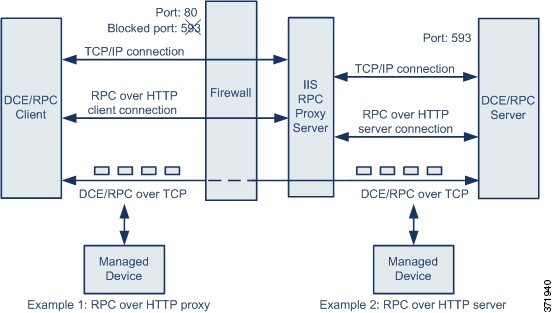RPC over HTTP Transport
Microsoft RPC over HTTP allows you to tunnel DCE/RPC traffic through a firewall as shown in the following diagram. The DCE/RPC preprocessor detects version 1 of Microsoft RPC over HTTP.

The Microsoft IIS proxy server and the DCE/RPC server can be on the same host or on different hosts. Separate proxy and server options provide for both cases. Note the following in the figure:
-
The DCE/RPC server monitors port 593 for DCE/RPC client traffic, but the firewall blocks port 593.
Firewalls typically block port 593 by default.
-
RPC over HTTP transports DCE/RPC over HTTP using well-known HTTP port 80, which firewalls are likely to permit.
-
Example 1 shows that you would choose the RPC over HTTP proxy option to monitor traffic between the DCE/RPC client and the Microsoft IIS RPC proxy server.
-
Example 2 shows that you would choose the RPC over HTTP server option when the Microsoft IIS RPC proxy server and the DCE/RPC server are located on different hosts and the device monitors traffic between the two servers.
-
Traffic is comprised solely of connection-oriented DCE/RPC over TCP after RPC over HTTP completes the proxied setup between the DCE/RPC client and server.